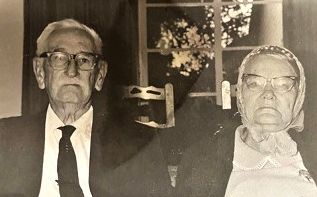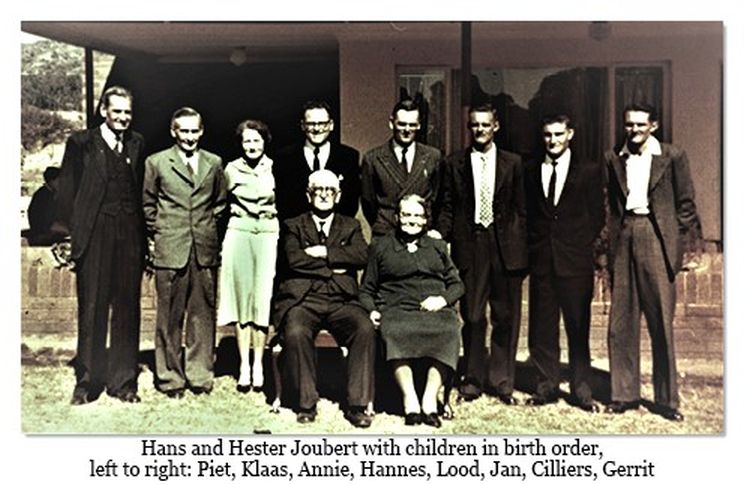View entry
Name: JOUBERT, Johannes Nicolaas


Nee: son from 1st marriage of Pieter Cornelius Joubert 'Rooi Piet' tto Catharina Elizabeth Grobler
Birth Date: 3 Sep 1885 Ermelo, S. Africa
Death Date: 29 Sep 1969 Phalaborwa, S. Africa
First Date: 1909
Profession: Farmer, the missionary in S. Africa
Area: Kilimanjaro, Lupa Goldfields, Oldeani
Married: In Moshi 20 Feb 1911 Hester Susanna Visser b. 17 Jan 1891 Lydenburg, S. Africa
Children: Pieter Cornelius (15 Mar 1912 Ngare Nairobi farm); Nicolaas Hendrik Visser (16 Aug 1913 Moshi-1971); Anna Sophia (Van Rooyen) (26 May 1915 Moshi); Johannes Nicolaas; Lodewikus Lourens; Johannes Stephanus and Jacobus Cilliers (twins); Gerrit Stephanus
Book Reference: Hut, Red Book 1912
General Information:
Willie Joubert: The farm Ngare Nairobi in Tanganyika was begun. Rhe WW1 broke out. Grandpa Hansie chose not to become a German citizen and continued to work on the farm. At a certain stage the Germans decided that those who were ‘neutral’ had to help in non-combat situations. They also moved the women and children to a camp for ‘protection.’ The camp was at the foot of Mount Meru. Dad Piet was a little guy and remembered how they moved to the camp on ox wagons. There were many trails made by the wild game through the dense brush they called ‘Beukebossies’ and they had a great time as little ones playing hide-n-go-seek. Grandma had a cat that was a great pet in the camp. In the meantime, the Germans ordered grandpa Hansie to help with transportation with his wagon. He felt it was enforced support for the war and he had stated his neutrality. He had no choice but to follow orders, unless he could find a way out. On his way with the loaded wagon along the steep and windy roads he ‘accidentally’ took a bend in the road in such a way that the wagon got jammed against a ‘haak en steek’ tree. This type of thorn tree is covered with fishhook like thorns and thus it was ‘impossible’ to get the wagon dislodged. The German officer Enke looked at this and in simple terms told grandpa Hansie that it was done on purpose. He was told he had a day to get the wagon to its destination, or he would be shot. All he had was a bayonet and with that he worked to cut the tree down and free the wagon. Following this the Germans interned him in camp. This was a special camp with guards. By this time the South African troops were advancing northwards into the country and Grandpa decided to go AWOL across the Kenyan border, 30 miles north of the camp. He was caught and warned. The next night he tried it again and got away. He walked through the night and by dawn was close to the border at Namanga. As it became light, he realized he was close to the road and tried to get away where he would be less visible. An Askari saw him and shot at him. The shot ripped through his right arm blowing one of the bones to pieces. The Askari then tied his hands and for medical help he was forced to walk to Oldonyo Sambu with his hands tied. That meant a journey of 70 miles before the military doctor saw him. From there he was moved to Dodoma. There he was placed in a room just outside of the hospital with a guard. He recovered and again disappeared. He had no weapon and the Dodoma area is fairly open with little place to hide. In the process he met Van Dyks that were also running from the Germans. The Germans spotted the refugees and followed them as they disappeared in a river. Nightfall saved them. They were on the opposite side of the river and overheard the Germans and the Askari tracking them discuss their situation and making a decision to abandon the pursuit. They decided to return to the Arusha area. Close to Arusha a Masai saw him and Grandpa ran to get away. The Masai called out that Arusha was full of British soldiers. Grandpa Hansie stopped and returned to find that the British were indeed in control. From there he was reunited with his family at the camp.
Willie Joubert:Pieter Cornelius and Lodewikus Lourens both fault in World War 2. Pieter was in Armoured Car Division in Somalia, Ethiopia and Madagascar. Pieter rose to rank of Sergeant and Lodewikusto rank officer. Lodewikus later served in Burma. Following the war, Pieter return to farm at Losinoni in Tanganyika and then Oljoro. Lodewikus farmed at Ngare Nanyuki in Tanganyika. Gerritt was a mechanic and worked as Stoker on the rail in Kenya and later as driver before working on farms and farming. Jan (JS) brackets later moved to Eldoret to farm and also worked on the railroad, and kill ears open brackets JC close was working on railways in Rhodesia and from there moved to Kenya to farm and also became auctioneer in Eldoret. Nicholaas Hendrik was a farmer/teacher in Tanganyika and moved to Kenya and married widow Dina Korf née Davis and farmed on her farm which Cilliers took over when they move to South Africa. That was what opened the door for him to move from Rhodesia.
